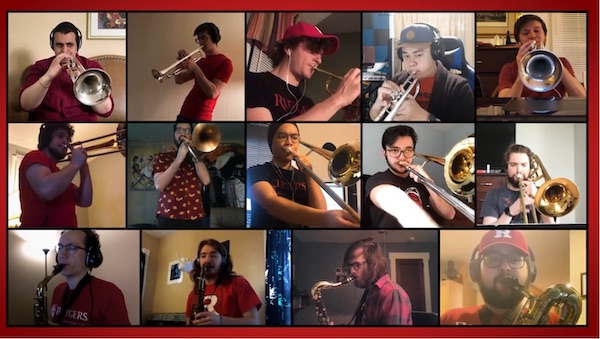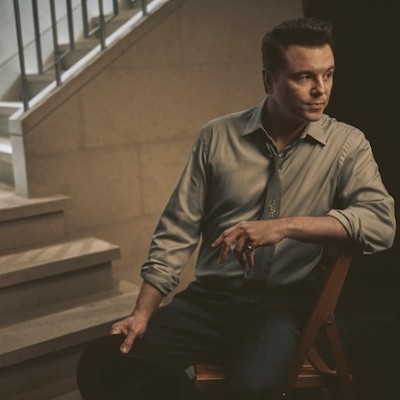Dec 9, 2025 12:28 PM
In Memoriam: Gordon Goodwin, 1954–2025
Gordon Goodwin, an award-winning saxophonist, pianist, bandleader, composer and arranger, died Dec. 8 in Los Angeles.…

In honor of its 50th anniversary this spring, Rutgers Jazz Ensemble produced a recording of Count Basie’s arrangement of “Strike Up The Band.” Audio and video elements were recorded remotely by student band members, with tech support provided by faculty and alumni.
(Photo: Courtesy Rutgers Jazz Ensemble)It didn’t take long for things to start clicking again. When coronavirus protocols sent students packing and forced school music ensembles to go online like the rest of academia this spring, jazz programs across the country proved adept at adapting to the new reality.
Several schools DownBeat touched base with this summer shared the creative solutions their jazz band directors and students came up with—on the fly—to complete the 2020 spring semester via remote instruction without losing the group dynamic that comes from playing together in the moment.
After all, you can’t simply have students dial in to Zoom and start jamming like normal. Latency proves to be a forbidding obstacle when musicians attempt to play together via standard teleconferencing. It takes a lot of tech-savviness and a sizable investment to get properly set up for real-time online jams, making it a luxury that’s too rich for most budgets and too complicated to configure for larger groups.
As a result, jazz educators and administrators had to come up with workaround solutions to keep their ensembles up and running—asynchronously—for the remainder of the semester. Some of their more effective ideas promise to shape the future of student ensemble instruction at the college level.
“It was ‘emergency remote learning’ in the spring,” said trombonist Conrad Herwig, a member of the jazz faculty at Rutgers University’s Mason Gross School of Music. “We had to pivot very quickly. Classes like improv, theory and private lessons are fairly easy to do remotely. But ensembles are the biggest challenge.”
Without a system in place or a standard platform to work within, Herwig and his students set out to record Count Basie’s arrangement of “Strike Up The Band” to honor the 50th anniversary of Rutgers Jazz Ensemble. Recording individually using the most basic of consumer audio and video technology, they were able to sync everything up into a highly presentable performance by a virtual live ensemble.
“It was a learning curve, and we realized that we’re going to have to have a system,” Herwig said. Their system of choice moving forward is BandLab for Education, a cloud-based collaboration platform that requires students to have a minimum amount of gear: a computer or laptop to capture the audio using a USB mic (or a regular studio-quality mic with an audio interface); a device to capture video, typically a smart phone; and a standard internet connection.
Herwig described each step in the process of making a virtual student big band recording. They start by creating a scratch track upon which the rhythm-section stems are built. Then the lead players record their parts, followed by the section players and soloists. The rhythm section players re-record their parts and comp with the soloists, reacting accordingly. The lead players record again to fine-tune, and in the very last pass, the drummer can go back and play as if it’s the first time through with the full band.
“The style, phrasing and articulation comes from the lead players from the top down,” Herwig said. “Intonation comes from the bass and the bass trombone and bari sax from the bottom up.”
Rutgers uses student mixing assistants to curate the feed and monitor everything as audio tracks are added. A production team will edit and sync up the students’ video submissions, so it looks and feels like everyone is jamming together.
“Post-COVID, there’s no going back to the way things were,” Herwig said. “There’s going to have to be some hybrid approach. What we’re trying to do is incorporate this technology and this virtual process into live rehearsal and performance. So, in the future, we’ll have both, which is a cool thing.”
The top jazz ensemble at University of Central Oklahoma was able to put together a spring recording project remotely using a combination of basic studio technology and smart phones.
“I was fortunate enough to have a drummer who had a studio in his house, and he was able to lay down tracks and send them to the bass player and keyboard player,” said Brian Gorrell, UCO’s director of jazz studies. “All three students were studio-savvy enough and had the equipment to do that. Then I sent a rhythm-section stem to the horn players, and most of them used their iPhones to record their part along with it. So, there was a video element. The finished product was one song that we worked on over a period of four or five weeks.”
Gorrell mixed the audio in Pro Tools and used video-editing software to bring it all together. “It was a huge time commitment” on his part, he acknowledged.
This fall, UCO jazz ensembles are to meet in person, but with strict CDC guidelines in place. The main performance space and audience space of the school’s Jazz Lab will be used for rehearsals, and concerts will take place at Mitchell Hall, UCO’s large auditorium.
“If there’s any situation where people start getting sick, within 24 hours notice we’ll go to a purely online model,” Gorrell said. “In that case, we would just be working on remote recording for the semester.”
At University of Southern California’s Thornton School of Music, jazz students were able to simulate a band experience remotely using material from drummer/educator Peter Erskine’s Jazz Essentials play-along apps for combos and big bands. “When the pandemic hit, luckily I had promo codes for all the apps,” said Erskine, who used to teach ensembles at Thornton but currently focuses on drum instruction. “So, I offered the apps free of charge to all the students.” He was able to accommodate not only the jazz studies department, but Thornton’s guitar department and pop music department as well.
“That at least allowed students not only to practice and be part of an ensemble, but use these for jury performances or to submit them for lessons or auditions,” Erskine said.
This fall, Thornton ensembles will rely on the new mfClassrooms platform, which is similar to Zoom and other teleconferencing methods but uses no audio compression or filtering. It provides a cleaner-sounding online environment that can accommodate instruments with large dynamic ranges and complex transients.
Erskine said online ensemble instruction teaches essential skills for aspiring pros. “It’s a perfect opportunity for students to work on their recording chops, learn how to play with a click track and make remote recording feel like it’s collaborative.” DB
This story originally was published in the October 2020 issue of DownBeat. Subscribe here.

Goodwin was one of the most acclaimed, successful and influential jazz musicians of his generation.
Dec 9, 2025 12:28 PM
Gordon Goodwin, an award-winning saxophonist, pianist, bandleader, composer and arranger, died Dec. 8 in Los Angeles.…

Flea has returned to his first instrument — the trumpet — and assembled a dream band of jazz musicians to record a new album.
Dec 2, 2025 2:01 AM
After a nearly five-decade career as one of his generation’s defining rock bassists, Flea has returned to his first…

“It’s a pleasure and an honor to interpret the music of Oscar Peterson in his native city,” said Jim Doxas in regard to celebrating the Canadian legend. “He traveled the world, but never forgot Montreal.”
Nov 18, 2025 12:16 PM
In the pantheon of jazz luminaries, few shine as brightly, or swing as hard, as Oscar Peterson. A century ago, a…

Dec 11, 2025 11:00 AM
DownBeat presents a complete list of the 4-, 4½- and 5-star albums from 2025 in one convenient package. It’s a great…

Seth MacFarlane takes a turn from his television and film career to sing arrangements made for Frank Sinatra, but never recorded.
Nov 18, 2025 12:04 PM
“I’m not gonna lie to you — I don’t know why I thought this was about The Naked Gun, but I’m happy it’s…